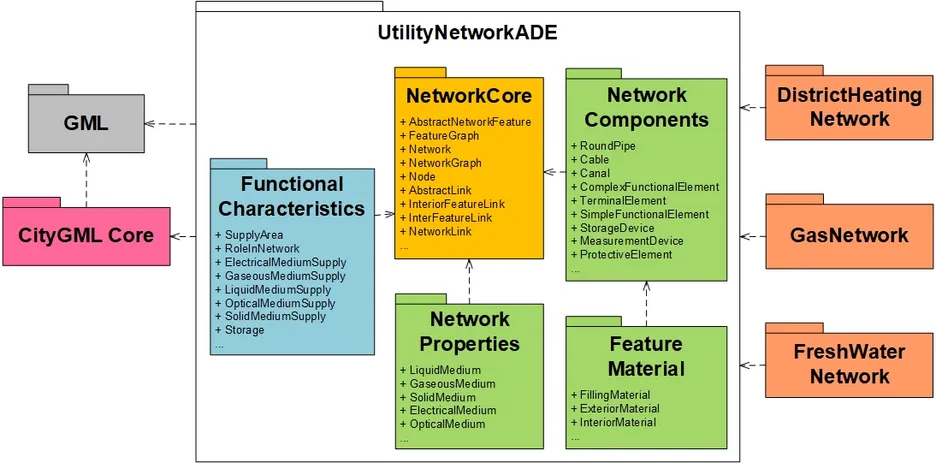The CityGML Utility Network ADE defines a common data model for representing different types of supply and disposal networks, such as electricity, freshwater, wastewater, gas, oil, district heating and telecommunication networks, facilitating sophisticated analyses and simulations which require an integrated view of 3D city models and supply infrastructures. Possible areas of application of the ADE are planning and simulation of district heating, electricity and freshwater networks, planning and operation of smart electricity grids, documentation and visualisation of utility networks, vulnerability assessment and disaster managemen, city system modelling and Smart Cities as well as facility management.
The first version was jointly developed from 2009-2012 by Prof. Thomas H. Kolbe, Thomas Adolphi (formerly Thomas Becker), and Dr. Claus Nagel at TU Berlin in the context of the collaborative research project "Simulation of intersectorial cascading effects in the failure of critical infratructures using the virtual 3D city model of Berlin" (SIMKAS 3D) funded by the German ministry of science and research (BMBF). In the research study "Risk analysis on critical infrastructures", in which the Chair of Geoinformatics participated from 2015-2016, the model was extended by Dr. Tatjana Kutzner and Prof. Kolbe. In 2016 a special interest group was founded consisting of members from academia and industry who are now working the revision and finalization of the UtilityNetwork ADE. It is the aim to include the UtilityNetwork ADE as a regular module within a future version 3.x of the CityGML standard.
The main characteristics of the CityGML UtilityNetwork ADE are:
- Simultaneous representation of heterogeneous utility networks, i.e. the ADE is not restricted to specific network types
- Dual representation, i.e. simultaneous topographic and topological representation of utility networks in 3D
- Hierarchical modeling on the feature level (component/subcomponents) and network level (network/subnetzworks)
- Representation of functional aspects, allows for analysing the impact of a network component failure on a certain region and the city objects affected in this region even without a detailed modelling of the supply networks being available
- Linkage between different types of utility networks as well as between utility networks and 3D city models, this is not supported by other existing standards
- Modeling multi-utility scenarios, this is not covered by other existing utility modeling standards
The Utility Network ADE is structured into five modules:
- Network Core: The most important module of the ADE, defines the topographic model (feature and network) and the topological / functional model (feature graph and network graph).
- Network Components: Provides the individual components of utility networks including distribution objects for transport and distribution of a commodity, protection elements relevant for network security, and functional objects for linkage, maintenance, and observation of a commodity / transport elements
- Feature Material: Defines the exterior, interior and filling materials of network components.
- Network Properties: Defines the commodities transported by networks and their characteristics (e.g. temperature, electric conductivity, pressure, flammability).
- Functional Characteristics: Provides the functional concepts supply area, functional role, and suppliability / suppliedness.
These five modules provide concepts which are relevant to all types of utility networks. Concepts required by individual network types only are defined within specific packages for district heating, electricity, gas, freshwater, etc., which are currently under development.

